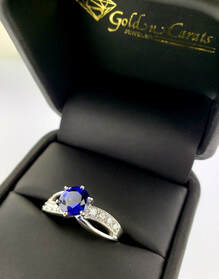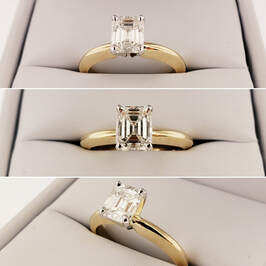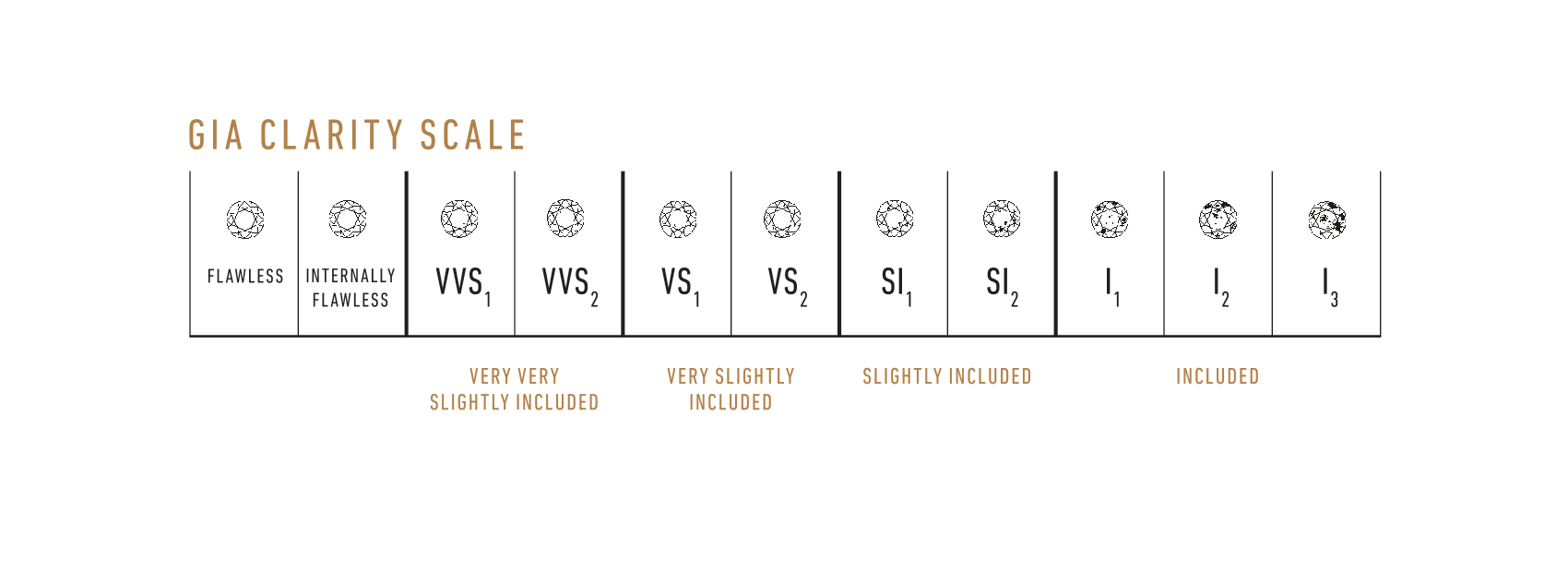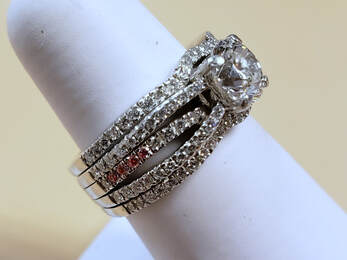|
We get a lot of questions about how soon an engagement ring can be ready for you to pop the question, so we wanted to offer some answers! Of course, there is not one specific timeline, since there can be so many different variables that feed into the labor and parts it takes! We will discuss various scenarios and what timelines generally are for each.
7 Comments
 Thank you for sticking with us this week - we've had a great time running through a lot of the options that surround purchasing an engagement ring! What happens when you just cannot find exactly what you are looking for? Maybe you have the whole thing planned out in your head, but can't quite picture what it will look like put together. Or, you have some inherited or family stones that you want to incorporate but haven't found a workable option yet. What we'd like to tell you....do not be afraid to go custom! Below we will go through some options for custom work. When does customization make sense?Please know, you do not HAVE to have a specific reason to go custom. Maybe that is just how you imagined it! Here are a few reasons that would lead us to suggest (or would necessitate) custom:
Different ways to "Go Custom"Generally, there are the following options on how to go through the customization process:  The simplest way deals with the smaller adjustments. If we can find a good baseline (an existing band or engagement ring, or a shank and a ready-built halo), then we are well on our way. This process typically involves making room for the additional part (removing a stone or two, etc.) and then welding/soldering on the additional parts. The nice thing about this option is that since much of the piece may already be manufactured, the cost is reduced from a fully custom price! The picture to the left involved taking a diamond band, removing 1-2 stones in the center, and then welding on a head for the purple sapphire the gentleman chose!  We are often requested to help make and design an engagement ring using a collection of inherited family diamonds/gemstones, but sometimes we are asked to incorporate parts of the inherited ring or pendant into a new design! We can do this too. Usually this means cutting apart the original piece to retrieve the sections that are wanted, and then a shank and/or supportive top sections can be ordered or crafted to support the structure and match the original design. That is what you will see here! Choose "Read More" to find out about other options, cost, and more! Now that we've walked through the "how" and the "center stone" side of things, it is time to talk STYLE. Many women have thought about what they have dreamed about for an engagement ring; however, there are a good number who haven't put time into considering design - and that is okay! Style is when an initial appointment as a couple can really help you to get a good idea of what she likes, but it is not necessary. Pinterest can be a great place to check out her ring style, too! Things To Consider Here are a few things to consider when choosing the right design: 1. Consider the style of her other jewelry. Does she like to make a big statement with her pieces, or does she choose daintier styles? 2. Though some women have the exact design they want in mind, they may want you to take charge and surprise her. It is a gift, after all, and may take some creativity springing out of your love for her & desire to honor her. 3. She will be wearing this every day for a good long while - make sure it's not too dainty of a design that it might bend or cause problems! 4. Trends are great and can have a lot of people swooning. However, you want to make sure that she is going to be happy with this for a good many years, unless you plan on doing upgrades often. Be trendy if you will, but consider longevity of style. 5. Make the design as fantastic as you'd like, but keep in mind safety - are there diamonds on the bottom of the band? Too lightly set stones? Edges of stones too exposed? We want to make sure that you don't experience any issues right away. We're here to help you find the right ring, but also to offer you our industry-tested advice so that you can design the best ring that will last! General Style OptionsIn the overarching engagement ring design world, there are a few "basic" categories to get you started. 1. The Solitaire [Classic] - This refers to a ring that has a precious metal shank with one single center stone at the top. The band may be simple, or have more intricate design. These have been popular for ages, and carry a timeless look that many women love. 2. Organic/Floral & Filigree [Natural & Whimsical] - For the more natural women, nature lovers, or Disney princesses. There are many gorgeous designs that have a natural flow to them, whether depicting leaves & berries, flowers, vines, branches, or anything of the like. 3. Engraved/Carved [Artistic] - Engraving or carving designs into the metal can bring a whole other dimension to a ring. It can be geometric, floral, or any number of more customized options. These rings may have any number of stones on them, whether as a centerpiece or incorporated into the design. 4. Vintage or Antique [Old World] - Maybe long ago she fell in love with her grandmother's wedding set, or perhaps she is an old soul. Vintage style rings often have beautifully combined elements of other categories that brings about memories of black and white movies. 5. Trendy [Of the Moment] - Right now, we are seeing a jump in rose gold & morganite center stone rings. Another couple trends that have been more popular (but we doubt will go out of style any time soon) are cushion halos with dainty bands and bands that have a twisty pattern to them, often with one twist being polished metal and the other set with diamonds. Is this the end of the list? By no means! This is meant to give you an introduction into some of the more common styles so that you can start thinking about what might fit her personality the best. Style ElementsThere are many different elements in a ring design that combine to make the perfect ring for your bride-to-be. Let's talk through a few of them, and you can decide what she might really enjoy, or what you may need to avoid! Here are a variety of options:
 Welcome back! Today we will get even more into the intricacy of diamonds with the final two of the "Four Cs," Color and Clarity! As we mentioned in our post yesterday, please note the limitation of doing all your research online. While it is a great place to start, seeing a diamond or colored gemstone in person and deciding what you prefer is essential! We love getting to walk our clients through an in-person learning session, so come on in (once the "shelter-in-place" order is null, that is). COLOR Grading the color of a diamond for most people does not refer to the pinks, blues, reds, greens, etc. Usually we are talking about the "colorless" to "near colorless" to lower grades, such as "top light brown" or getting into a faint yellow tint. When grading color, we are more concerned about the absence of color than the presence of it. The greater the absence of color, the higher letter grade the stone is. What is most desirable? If you are going by highest price and greatest rarity, then the "colorless" grouping is where you'd look. Here is a look at the scale: When GIA came up with the color grading scale, they nixed A, B, and C altogether. It appears that there were too many stores adding additional "As" to their A gradings and it became quite a mess. Thus, the diamond grading with the most absence of any color is deemed as "D" color. "DEF" is spoken of as the "colorless" range. We then make our way down to the "GHI" range, called the "near colorless" range. With these, you may see a slight tint of yellow or brown, but it should be very faint and most easily seen when placed up against a DEF diamond. Going further down the scale, the JK range starts to show more visible tinting even when not contrasted to a more colorless diamond. LMN gets more tinted, and in this range or the OPQ range we can start to see some diamonds labeled as "faint yellow" or "top light brown." The lower colors are not useless! Though these colors can be more obvious in a white gold or platinum setting, they blend much better in a yellow gold or rose gold setting. We've done many beautiful rings in the lower colors - we want to make the perfect piece for you and your bride-to-be, not impose our own preferences on you! For more information and helpful diagrams, check out these articles from GIA, Diamond Color: Seven Things You Need To Know and GIA 4 Cs Color. CLARITY Just like the previous two categories, this is also something you should experience looking at in person to see what your preference would be! Our customers are varied in what they like, and so we like to show a range of options to find what is right for you. Clarity refers to internal imperfections, or inclusions, and outer imperfections, or blemishes. Here, we will talk about diamonds specifically. What are these imperfections, and what causes them? It is almost always due to trace elements that were present within the diamond at formation. They can be white or black (much more rare is other colors) and depending on what they look like, have different names. Feather, cloud, cavity, crystal, knot, or my personal favorite because of its name, twinning wisps. Again, there is a grading scale! Diamond clarity is graded at only 10x magnification (what we will show you in the store is a 10x loupe) and depends upon the position, size, number, and visibility. On this scale, with the highest grade at the top and the lowest grade at the bottom: But what do all these gradings really mean?
Well, you've made it this far! Whether or not you've got all the details in place, you have at least begun the journey to designing the perfect engagement ring for your beautiful bride-to-be. As you know, detailed information on how to choose the right diamond for you & her, or choosing another gemstone, was not something taught at your local high school. But we want to help introduce you to the ins and outs of diamonds and gemstones! Please also note the limitation of doing all your research online. While it is a great place to start to get you familiar with the terminology, it cannot be compared with seeing a diamond or colored gemstone in person and deciding what you prefer! We love getting to walk our clients through an in-person learning session, letting you loupe diamonds and become familiar with the gradings. About Diamonds: Intro to the "Four Cs" There are four very important categories to consider when looking at diamonds! Cut, Color, Clarity, and Carat. Now you may be thinking, are the way these categories are graded simply up to whichever mine or jewelry store is selling the diamond? That's what used to happen. Then, the Gemological Institutes of America, or GIA, came along and said, there has to be a better way to simplify these gradings across the world. And so they did! As these categories can get pretty complex, we are splitting the 4 Cs up into two posts. Part 1 includes Cut and Carat, and tomorrow we will introduce Color and Clarity! CUT Cut refers to not just the shape of the stone (round, princess/square, oval, emerald, cushion, asscher, marquise, pear, etc.), but also the proportions, symmetry, and polish of the facets. Why are these important? Well, you certainly want whatever diamond you present to be sparkly and dazzling, even from across a room. The better/more precise the cut, the better the sparkle, at least in theory! Two things we commonly consider when talking about the cut is the depth of the stone and the size of the table (the largest, flat, top facet). The depth is critical because of the reflection of light. Too deep or too shallow, and the light reflects off to the side or beneath the stone. Ideally, the light enters the stone and returns back to you! The table size also plays into how light reflects. Proportions and symmetry are important on all the cuts, but are most commonly assigned a full 3-step grading when looking at a round brilliant cut stone. Maybe you've heard of a "Triple X" stone - all this means is that in cut (proportions), symmetry, and polish, the grading has been deemed as "excellent." Many "Triple X" diamonds are ideal cut (mathematically the most brilliant, reflecting properly the most light), but not all are. Here is the range of cut grades, from lowest to highest: This can be tricky, as some less-than-honest salespeople can tell you all about how a stone is a "Good" cut and try to make it sound like it is a great rating, but really, that is in the middle of the scale! (Unfortunately, we've heard of it happening plenty of times.)
Now, do you HAVE to have an Excellent cut stone? By no means. Measurements and gradings can get you pretty far in finding a great stone, but ultimately each diamond is unique, and one may sparkle more than another, even with a lower cut grade. Come in to see & find out for yourself! CARAT Carat refers to the WEIGHT of a diamond. In a well-proportioned/cut diamond, this will mean very similar dimensions across the same carat of stone, but not all diamonds are cut the same. The term "carat" comes from the origination of how people measured stone weight! In older societies, one carob seed was held as the standard measurement, which translates to one carat of diamond weight. Carob seeds were known for being so exact in weight from one to another, and thus is why they were used. (Interesting fact - there was a slight variation of the weight of seeds from one region to another, which caused some issues!) One carat is 0.20 grams (difficult to measure on a normal scale). For engagement ring center stones, we have seen quite a variety of sizes over the years. There is something special about the 1 carat mark that can get a lady excited, and we understand! However, each person is different and has unique preferences; so what is the right size diamond for you? To the men who are considering popping the question: we are here to help! There can be a great deal of pressure and unknowns when thinking about proposing. How do I ask? Will she say yes? (We hope you have a good sense of that one first.) Where do I start with getting a ring? How do I know her size...or style? Take a deep breath - this week we are going to walk you through many of these questions this week! Where do I start? What we have noticed that for most men (unless he is wanting it to be a complete surprise) is that they've already talked to their girlfriend about hopes for the future, like wanting to get married. If this is the case, then you already have a good start! If you've talked about getting married, then that may leave an opening for more questions: style, size, and more. We've had many couples come in for an initial appointment to look at rings together. This can be extremely helpful for the men, and we take care not to "spoil" any surprises! Our staff seeks to help you consider a few different things:
What we try to avoid bringing up in front of your lovely lady are these three things:
Now, if you want her to be involved in these things, that is up to you and we are happy to oblige. Just let us know! If you decide not to bring her in for an appointment - which is okay!Do not worry, we are not at all saying that a joint appointment is necessary!
If you are wanting to get answers on style, there are a couple options without asking her directly. You can try: There can be so many terms to describe colored gemstones - what do they all mean and why is it important? Below, we get you the answers you're looking for! Note that here we are talking about colored gemstones. Diamonds are typically separated in how we talk about them - we will have an article up about diamonds later! Natural Gemstones This one is pretty simple - a natural gemstone is a mined-from-the-ground stone that has an underlying chemical makeup and crystal structure normal of that specifically named stone. It was not made in a lab! For most stones that we can mine & find in the earth, there are now synthetics & imitations for those stones. Now, a natural gemstone does not mean that it has not been altered or treated in any way once it came out of the ground. Actually, a vast majority have been treated in some way (irradiation, heat, pressure, oil, etc.) to either bring out the best color, stabilize it, or reduce the visible inclusions. For example, nearly ALL natural Tanzanite stones (still only mined in Tanzania) are treated after they come out of the mine - the rich bluish purple that so many desire often begins as a brown stone! What is the benefit of a natural gemstone? The value and the rarity are the biggest factors that make a natural stone preferable over a synthetic or an imitation. Also, know who you are gifting a piece of jewelry to - would they prefer a natural stone? Not many stores will purchase a synthetic gemstone to resell, either. Synthetic Gemstones Repeat after me: Synthetic and Imitation gemstones are NOT the same! Synthetic gemstones have been around since the 1800's when a chemist in France first started with synthetic rubies (corundum) and created one of the processes called flame fusion which is still in use today. Interestingly enough, though he had discovered and reported on the process in 1891 to a university in France, he did not go public with the news until 1902 - we have to wonder, what happened in that 11 years? Synthetic gemstones are based on the real thing - the same chemical and crystalline structure that is found in the natural stone. Synthetics are typically made to imitate the cleanest (inclusion wise) and most desirably colored version of the natural stone. Not all synthetics are the same! Many different companies make synthetic gemstones. What is held as arguably the best and most well-known of the synthetic labs is Chatham, who has been around since 1938. Common gemstones that are available as a synthetic stone (not an exhaustive list):
But why make a synthetic? Or why not? While you are stuck at home with no access to our FREE cleaning & safety checking for your jewelry: here's a few tips! We want to keep you clean and ready to go - especially with all the health concerns of the coronavirus right now. So how do you keep your jewelry clean? What about all the handwashing and commensurate lotion wearing? Below we will talk about how to keep your jewelry clean and safe until we can see you again! Safety Checking is KEYAt Gold N Carats, we always check your pieces under a microscope before and after professional cleaning to see if there are any concerns! Now, at home, you likely won't be checking your pieces under a microscope. However, there are a few things you can watch out for at home. If one of these things is true of your piece of jewelry, we strongly suggest NOT TO WEAR IT until you can get our professional opinion:
We don't like to be "Debbie Downers," but we want to keep you safe on a daily basis! The other thing that we will suggest (because things like the ones listed above can happen to anyone) is to GET YOUR JEWELRY INSURED! Don't be caught without it on your precious pieces & family heirlooms. How do I clean my jewelry at home?NOT ALL JEWELRY CAN BE CLEANED THE SAME WAY. We cannot emphasize this enough. Part of why we offer free cleaning is for that reason! But at home, what can you do?
We get this question nearly every day. How do you size a ring? Well, the lucky thing is - I'm not the one who is sizing it! Thank goodness. You would want a real professional! So, we go to our head jeweler, a Jewelers of America Certified Master Bench Jeweler, Jim Rogers. These days, we have a laser welder that helps our jeweler to be able to size rings faster and more precisely. (There will be a later post on the benefits of laser welding.) However, there is still a time and a place for the time-tested torch method. Sizing Down Question: So how do we reduce the size of a ring, or size down? Jim Rogers: I first get an accurate reading of what the current size is, and if it is "out of round," [ovaled, bottom flattened, etc.] I round it out. Knowing what size to go down to allows me to gauge how much metal we are taking out. Q: Taking out? Is that how it works? J: Yes, I cut a line in the bottom of the ring, cutting out a section long enough to get to the new smaller size. Q: Then what happens? J: I carefully reshape the ring down to its new size and using solder, connect the two cut ends. I then make sure that there is no mark left where the ring was sized, as that would not be proper work if there was! Q: What about the extra piece of gold or another metal? What happens with that? J: I believe that is worked into the price of sizing down. It is usually so minuscule that it doesn't account for much. Q: Are there any issues that can come up if this isn't done properly? J: Yes - if too much solder is used and not enough of the original metal to fill it in, there can be "bubbles" left over and a mark - if there are bubbles it is called "porosity" [more on this later] and leaves a weak spot in the ring. It would be more likely to break there. Sizing Up Question: Okay, so we know how sizing down works. What about sizing up? Jim Rogers: Definitely possible. Once we know the old size and the needed size, I determine how much gold [or silver, platinum, etc.] needs to be added in. Once I know this, I can cut a spot at the bottom of the ring to add a piece in, and check if I have the right sizing piece that is a little thicker than the ring. Q: What do you mean "thicker?" What part of the ring do you mean? J: I mean the depth of the ring. Say you have a ring on and you press it to a flat surface - the distance between the surface and your finger would be the depth. Q: Why does the sizing piece have to be thicker? J: Because, after I weld [or solder] the new piece in using a combination of solder and gold [or silver/platinum], I have to file down the insert so that it is the same thickness as the rest of the ring. That way I make sure I don't leave a portion of the ring thinner than it was when it came in. And as I mentioned with sizing down, I make sure to not leave any "lines" to show that the ring was even worked on. Q: Are there any issues that can come with sizing up if not done properly? J: The same with sizing down, if the piece is not welded in right, it can break and come out. We don't do it this way, though! When to choose something other than sizingQuestion: Is there ever a time that you would NOT want to size a ring the ways you described?
Jim Rogers: Yes, actually. If a ring is too thin [refer back to depth of a ring] then I do not like to size it, as we can't warranty the work. Q: No warranty on thin sizings? Why? J: When they get so thin, it's common to have bending or breaking anyway, and so we cannot guarantee that that won't happen. Q: What do you suggest instead? |
AuthorAssistant Manager Jenna Rogers gets the answers from our jeweler to your most important jewelry questions! Archives
February 2021
Categories |
Christmas HoursMon-Fri: 10am - 6pm
Sat: 10am - 5pm |
Phone(972) 910-0300
Call or Text |
|
Address
7750 N MacArthur Blvd #100, Irving TX 75063
|
















 RSS Feed
RSS Feed



